
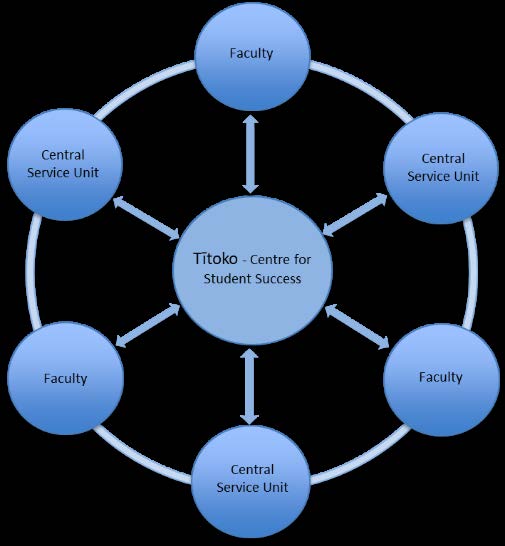
ii.
Student Retention – The establishment of a shared student success framework
(Appendix 1) which presents a co-ordinated and sustainable approach to connecting
students with support to help them navigate academic and university life. This wil
involve the creation of a student retention data model which identifies at risk students,
a reporting framework that is timely, accurate and can measure effectiveness, and an
advisory model that is informed by meaningful student data and is sensitive to the needs
of each student cohort.
iii.
Multi-channel Student Service Centre – The creation of a centralised, efficient and
professional student service centre where students can access consistent help and
advice across multiple channels. This will involve the standardisation and centralisation
of non-specialist services from faculties, schools and central service units. It will also
contribute to self-service capability through the digitisation and automation of relevant
services via a student portal.
iv.
Enabling Technology – The implementation of technology solutions that wil capture the
student journey, provide accurate and meaningful data, streamline and automate
processes and procedures and enable students to self-manage relevant services. The
core technology will be the implementation of a new CRM that will record student
transactions and enable a holistic 360-degree view of student interactions with the
University. This will also require integration with key student systems as well as
providing requirements for a student portal to increase self-service.
v.
A different way of working–To move from operating within silos to become a truly
integrated University where we are able to use our resources - people and systems -
wisely and flexibly to best serve our students (i.e. able to quickly adapt to both internal
and external influences) will require a new approach in how we work. Subject to
business case approval, Tītoko – Centre for Student Success wil be established, and
further detail about this is provided in the update paper.
This will involve centralising the core student
administrative functions including exams and a
holistic student advising service (the hub) with
links back to the faculties and CSUs (the spokes
and rim). The hub will be efficient, effective and
digitised and the spokes wil be proactive,
personalised and informed by rich meaningful
student data. Initial y the size of the Tītoko -
Centre for Student Success is approximated at
100 staff currently fulfilling these functions within
the University. The final shape and size of the
Centre wil be determined based on the feedback
from the update paper, efficiencies gained from
centralising and digitising processes and the formal change proposal.
Student Success Programme Business Case - FINAL
2
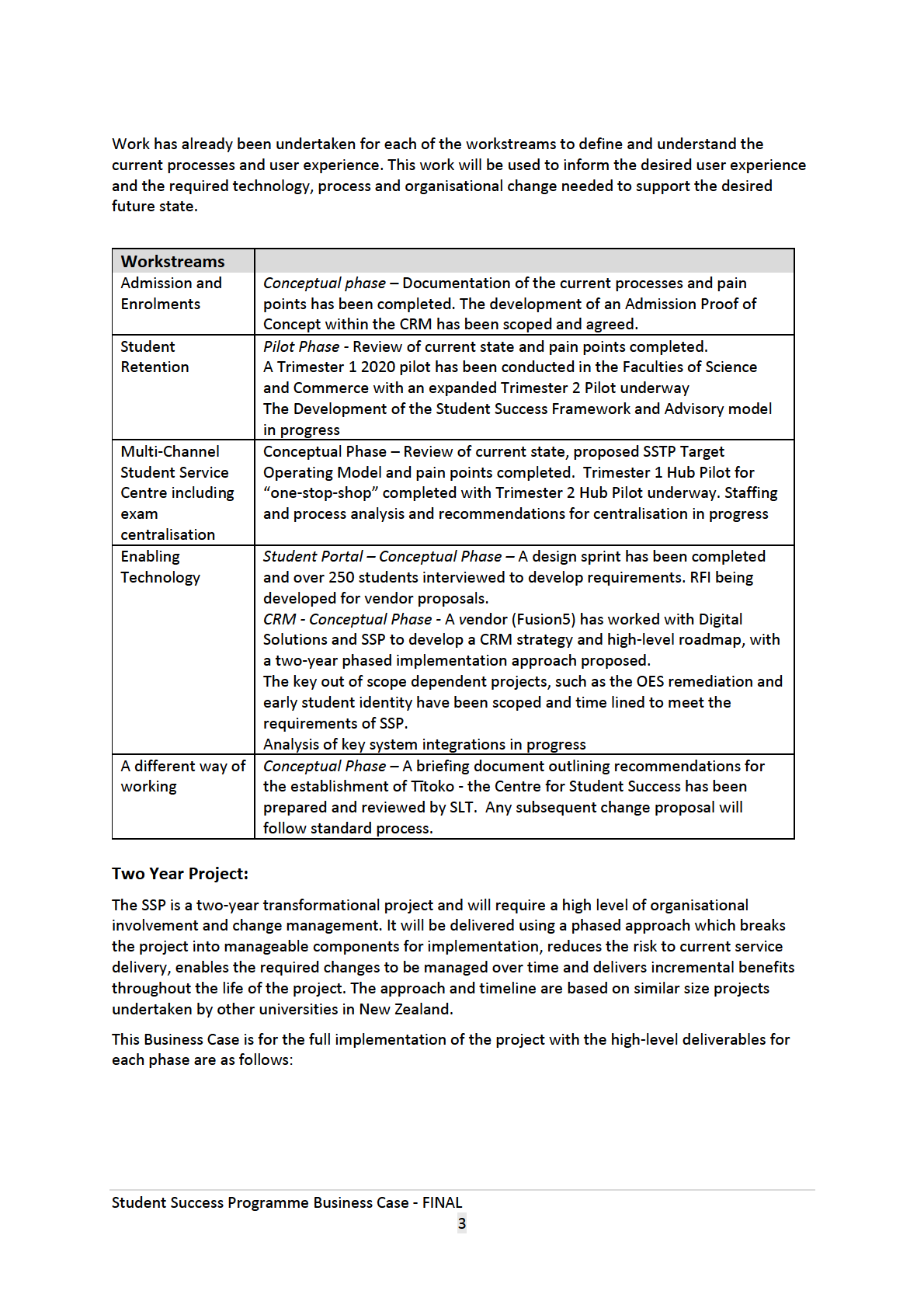


There will also be six monthly “Review Gates” for the project to report back to SLT. This is to ensure
the project it is on track and delivering as promised and will also provide the project with clear
decision points at key parts of the project. `
Project Review Gates:
2 STRATEGIC RATIONALE
The Student Success Programme is one of the key strategic projects that will deliver against the
university strategy.
Education preparing students for an extraordinary life
The Student Success Programme wil transform the way students connect and engage with the
University. This starts with nurturing students from admission through to enrolment, providing
personalised advice which will follow them throughout their journey, the early identification and
intervention of students who require complex support and the delivery of services that students
value. This will create an environment from which students can achieve their educational
aspirations.
Equitable outcomes for al
The implementation of a holistic student advisory model will enable targeted and differentiated
support for each cohort of students and ensure that the support provided is timely and sensitive to
the specific needs of each student.
Student Success Programme Business Case - FINAL
4
Transforming the way we work The standardisation and centralisation of core student services underpinned by technology wil
transform the delivery of student services. It will remove duplication and manual processes and
enable students to self-manage appropriate. This will provide the foundation for the holistic student
advisory service that will enable staff to focus on services that students value.
3 TARGET OUTCOME AND BENEFITS
Target Outcome:
The target outcomes of the Student Success Programme are:
• Students wil access services that they value at a time, place and channel that works for them,
and can expect consistency of experience - irrespective of where and how services are delivered.
• Service offerings will be substantiated with rich data about students and their needs to pair
individuals with the right services and interventions. This includes providing a comprehensive
student advising service within and across faculties with centralised administration and support,
leading to academic success for our students.
• Our staff will benefit by being provided clear and consistent pathways for career development
and progress across the university.
Benefits:
The strategic benefits to the University from the Project are:
1.
Increased student enrolments – The separation and centralisation of the admissions
function will improve efficiency, increase “inquiry to enrolment” conversion and enable
student admission all year round.
2.
Improved student performance and retention – Proactive monitoring of student
engagement and performance will enable early intervention of at risk and underperforming
students.
3.
Connected and engaged students – The development of a personalised and supportive
environment through a student advisory model wil ensure students are more connected
and engaged with the University.
4.
A holistic view of students – The creation of a 360-degree view of student interactions will
better inform the delivery of student services and future decision making.
5.
Improved student experience – The provision of intuitive and personalised digital tools will
enable students to access services when and where they want.
6.
Improved efficiency and productivity - The removal of paper forms, manual processes and
duplication will improve the delivery of student services and enable staff to focus on services
that students’ value most.
7.
Cost savings - A reduction in the cost of service delivery through the standardisation and
centralisation of student services functions and processes will improve cost efficiency.
8.
Staff development – The establishment of a defined career path for staff who support and
advise students will provide opportunities for career development and advancement.
9.
Continuous improvement –The establishment of systems, processes and operating model
will provide agility and enable ongoing improvements to be realised.
10.
Risk reduction – Reducing the risk of lost revenue through the low conversion rate and early
exit of students.
Student Success Programme Business Case - FINAL
5
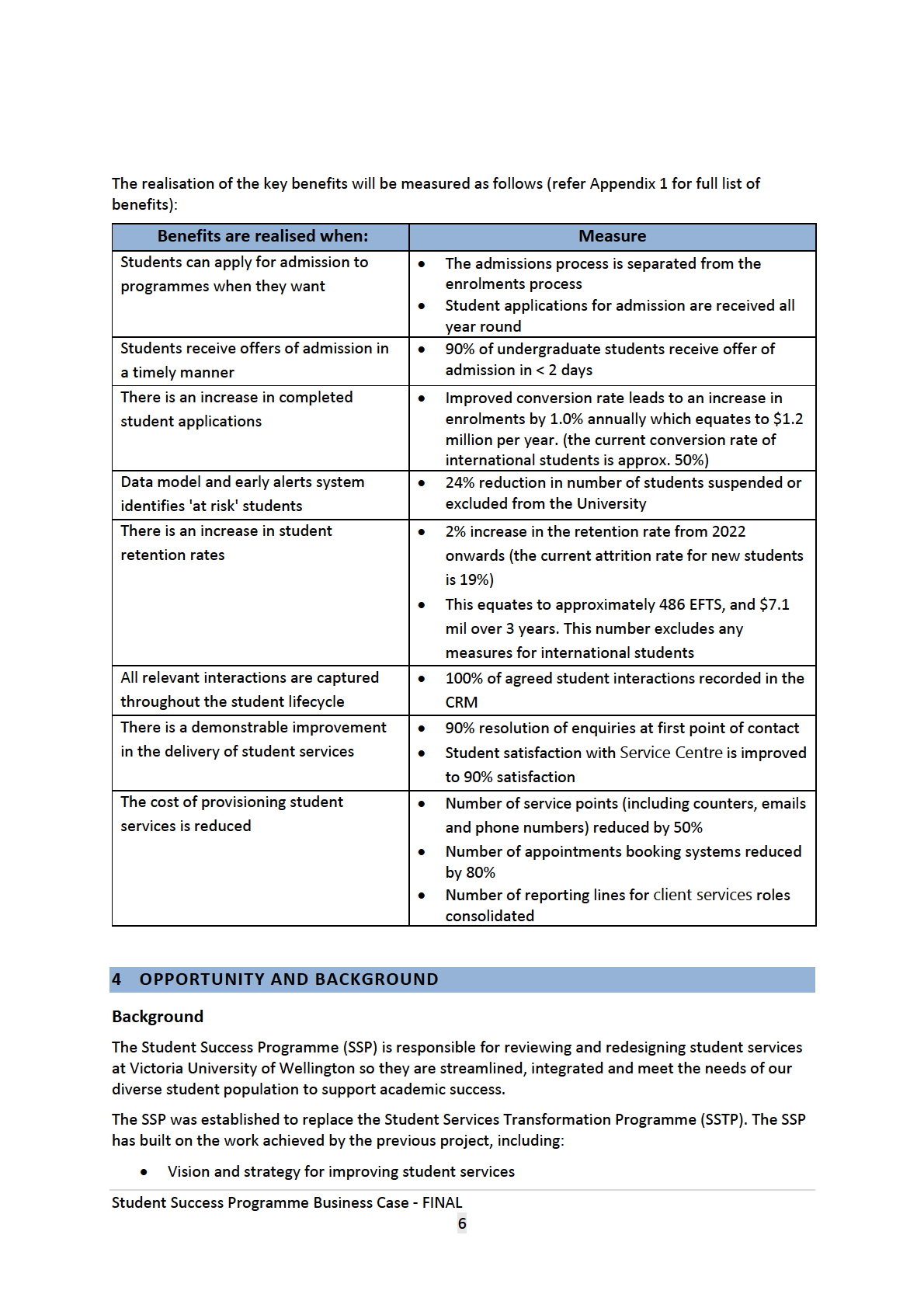

• Engagement with staff and students
• Analysis and design work
It has also taken on board the recommendations from the KPMG and PWC reviews. This has led to a
re-focusing and re-shaping of the project to clearly define the scope, deliverables, costs and
timeline. The project has overall responsibility and oversight of three workstreams:
• Admissions and Enrolments
• Multi-channel Student Service Centre
• Student Retention
The project’s work also includes implementing enabling technology centred around the
implementation of a student portal and new CRM solution. A new student support model that will
recommend pan-University organisational change for a hub, spoke and rim student support and
advising model operating from Tītoko - the Centre for Student Success. This will involve centralising
the core student administrative functions (the hub) and a holistic student advising service based in
the faculties (the spokes). The hub will be efficient, effective and digitised and the spokes will be
proactive, personalised and informed by rich meaningful student data.
Opportunity to improve the student enrolment experience and University’s competitive
position
The problem is that students find it difficult to access the right information, systems and services they
require to apply, enrol and manage their studies, at the right time. In the most recent student survey
only 69% of new domestic students expressed satisfaction with their enrolment experience. This
provides an opportunity to
• Update the admission and enrolment processes to enable the university to compete in a
complex and competitive environment.
• Centralise the admission and enrolment teams and the decision-making authority to provide
faster turnaround of student applications.
Student Success Programme Business Case - FINAL
7
• Removal of required manual intervention related to the application and enrolment process
freeing up staff to focus on value-add tasks.
• Provide international students and agents the ability to manage their admission and
enrolment process online, rather than by paper submission.
• Remove the requirement for domestic students to apply and enrol in one single process
which will eliminate the current administrative bottle neck.
• Provide earlier and richer pipeline reporting thereby enabling the University to make some
informed and tactical recruitment marketing decisions.
Opportunity to deliver services that students value
The problem is that services for students are delivered from siloed teams across multiple locations
which results in an inefficient and inconsistent service to students; bouncing them between teams
with no coherent view of what they need. This provides an opportunity to:
• Establish a centralised and cross-trained team who can consistently and professionally
deliver administrative and student services across channels and locations without
unnecessary referrals. Capture university knowledge and student services data central y to
enable a consolidated view of each student and inform service delivery processes.
• Provide automated processes for staff and self-service options for students, removing
manual processes and workarounds wherever possible.
The problem with the current examination model is process inconsistencies, unnecessary duplication
of effort with limited opportunities for efficiency gains and benefits that could be gained through
systemising processes. Centralisation of the team would provide an opportunity to:
• Efficient utilisation and training of staffing resources including invigilators;
• Embed best practice to meet the needs of the student body in particular disabled students;
• Provide greater opportunity to fully utilise functionality of current timetabling systems;
• An ability to roll out digital examinations.
Opportunity to improve student retention
The problem is that there is no clear student success model that addresses the changing nature of
student preparedness for university study and this impacts the University’s ability to retain students
and provide a consistent high-quality student learning experience. The first year attrition rates for all
new students is 19% and 24% for Maori and Pasifika. This provides an opportunity to:
• Utilise data pertaining to each student, throughout the student’s journey, to proactively
identify when a student is at risk of failure, rather than wait until the end of a trimester or
when the student withdraws from the University
• Provide University wide tools and systems to define and evaluate student success, provide
success measures and support activities to support the student at each stage of their
learning journey
• Provide a consistent holistic advising model across the university to all students providing
value add services
Consultation Undertaken
• PAMI was consulted to provide market and enrolment information; retention information
and at-risk data modelling
• SSTP Design Sprints with students and staff on desired future states for student services and
student success
• Reference Groups established for consultation and validation of current and future state
designs
• Student feedback from retention pilots and HUB service centre pilots
Student Success Programme Business Case - FINAL
8
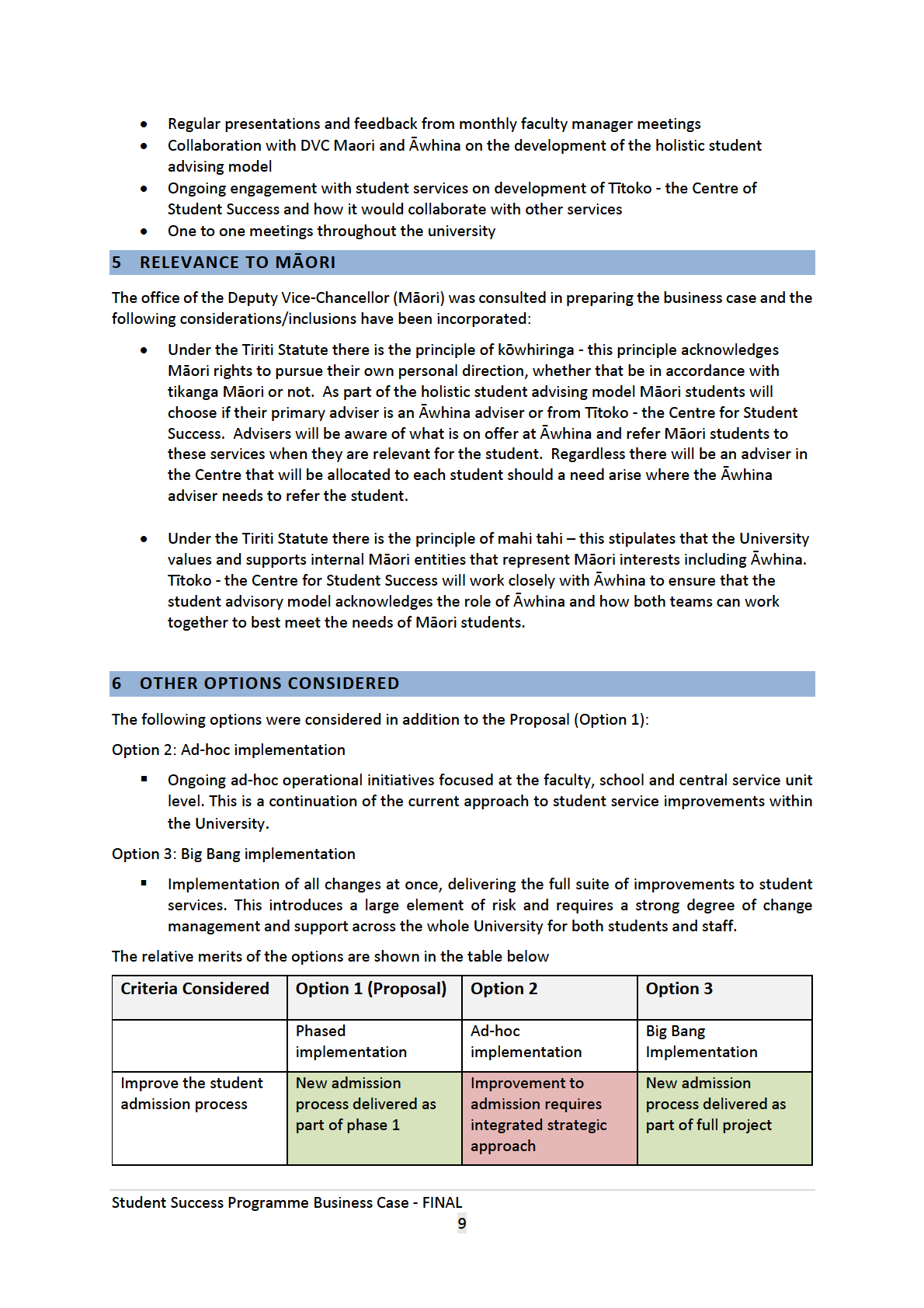
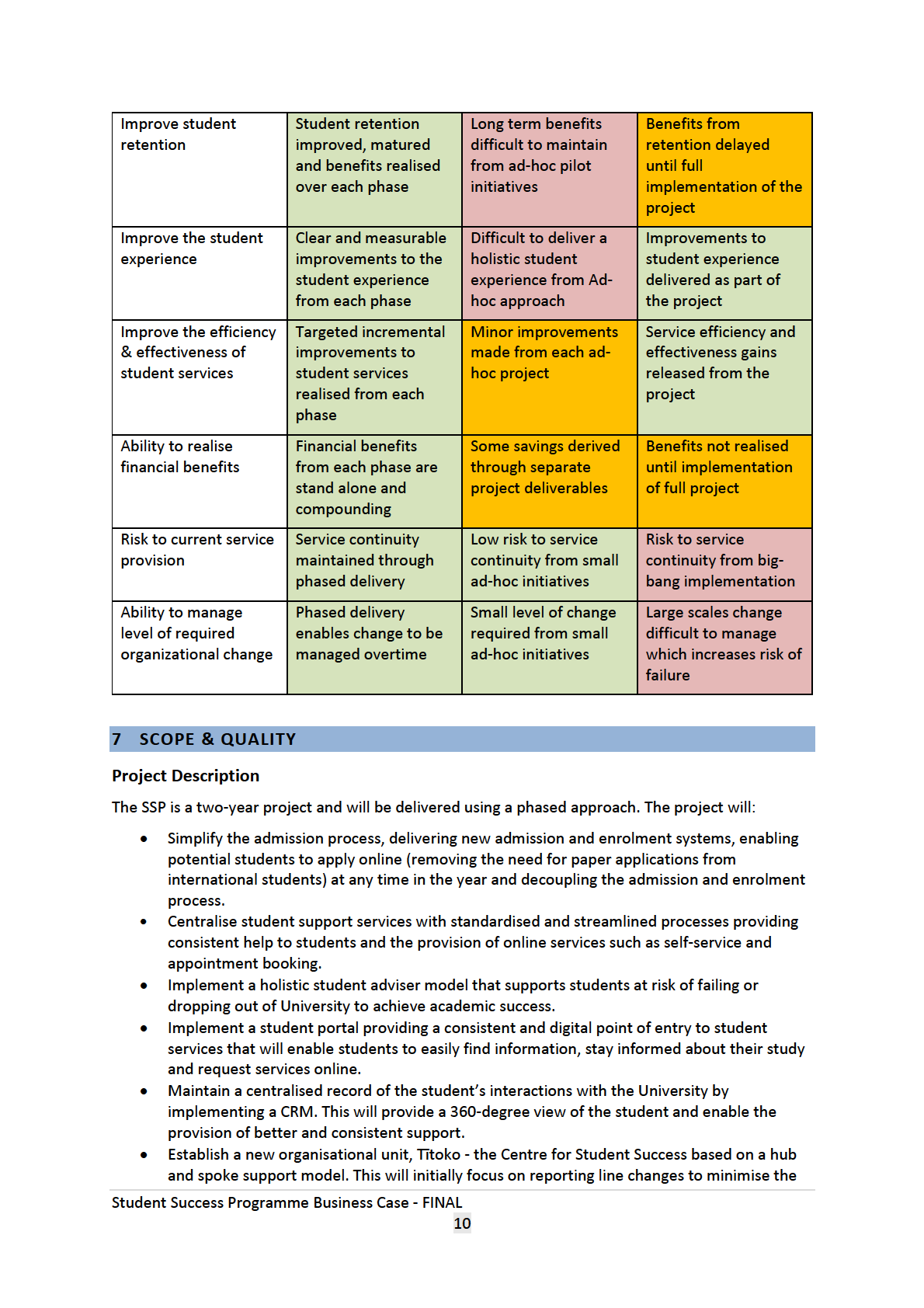
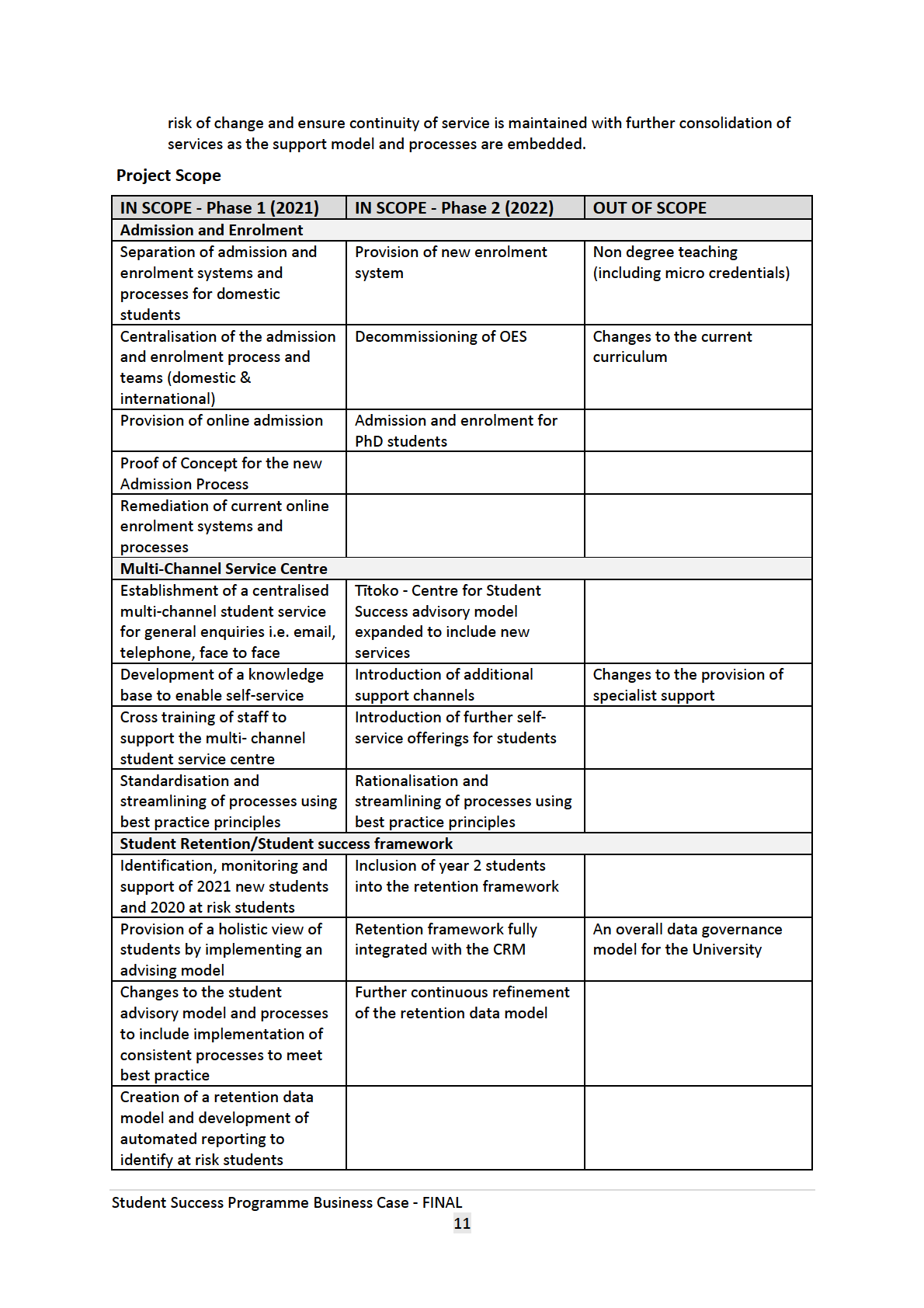
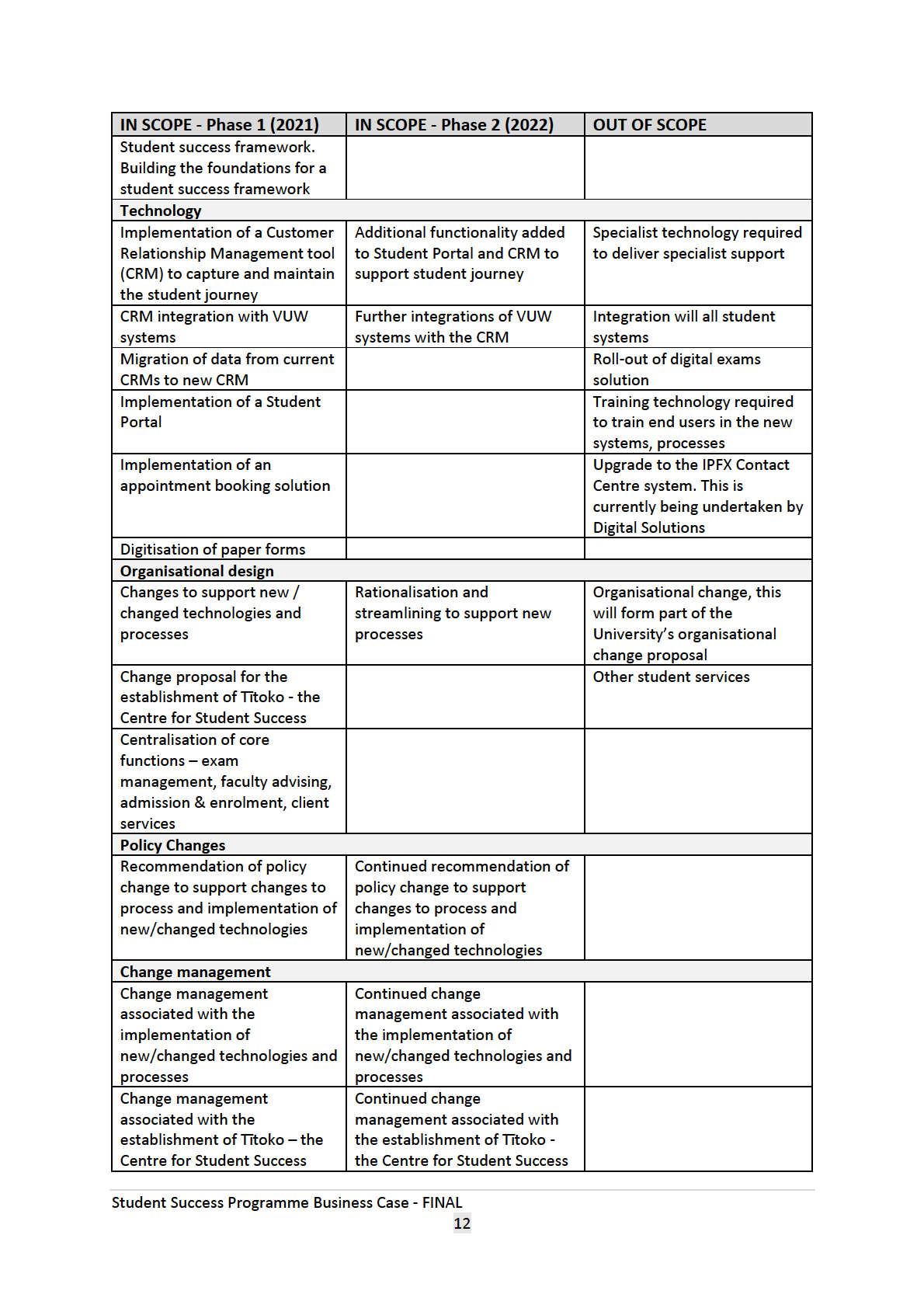
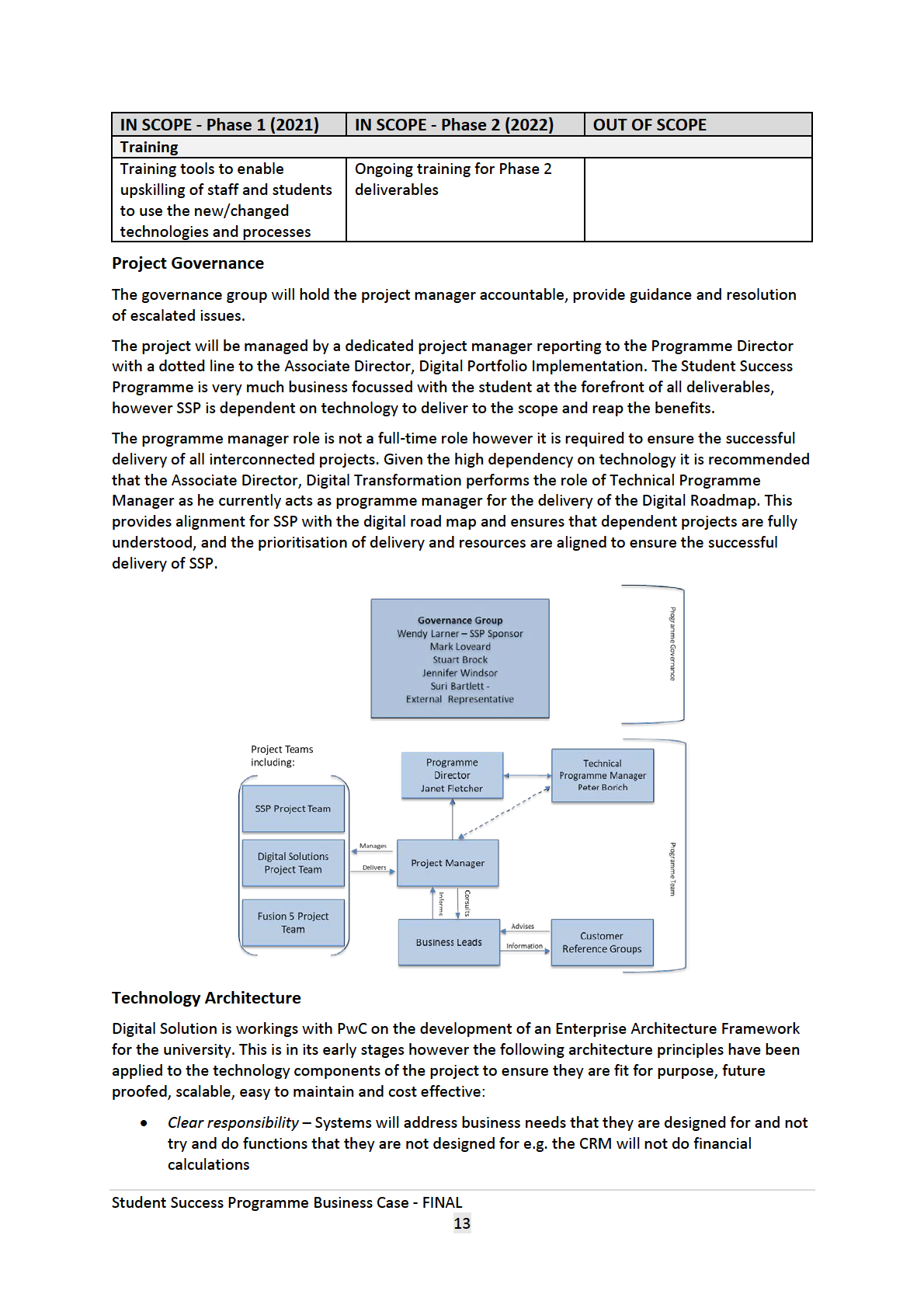
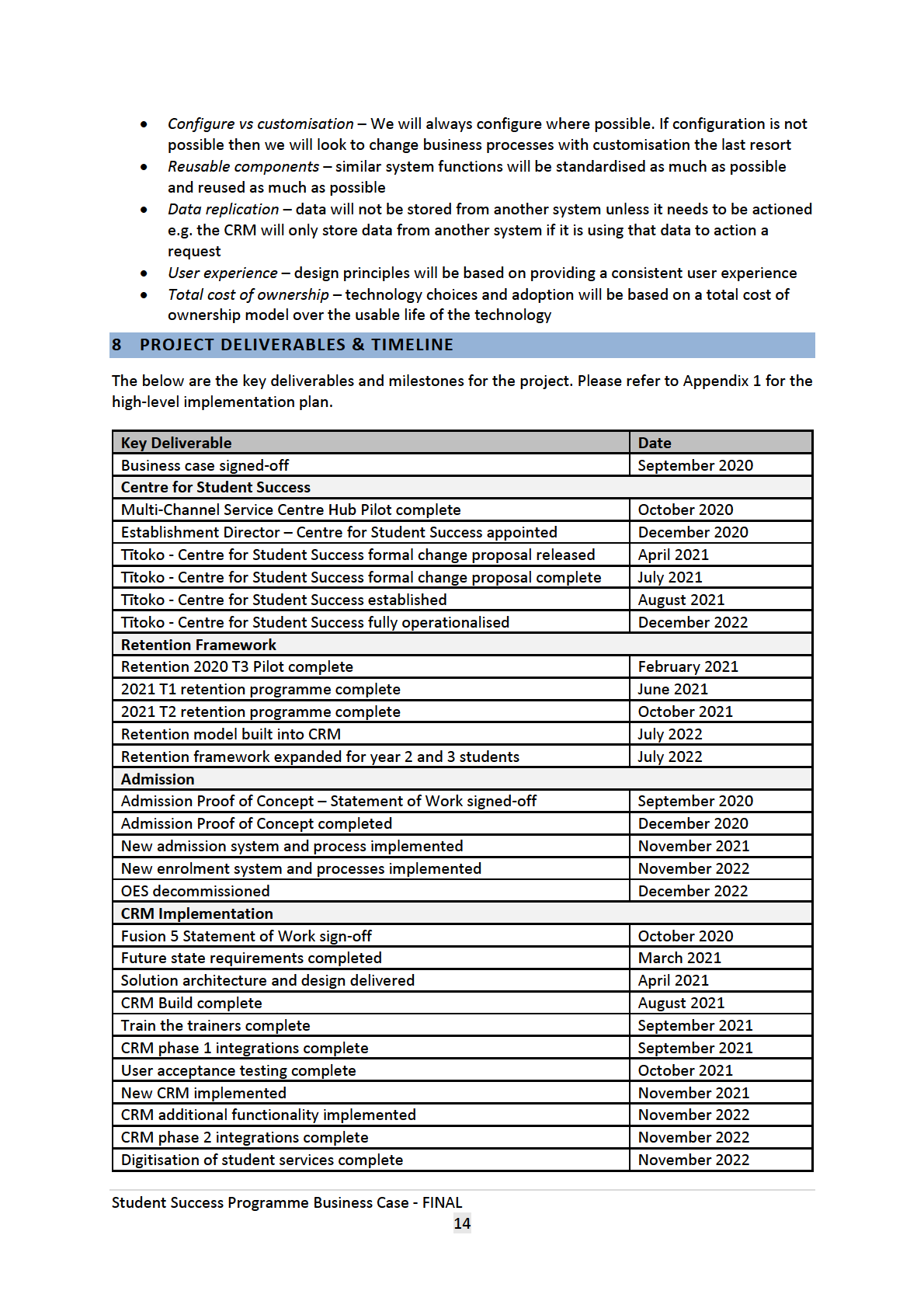
Student Portal
Analysis and RFI to select student portal vendor
December 2020
Student Portal vendor selected
December 2020
Student Portal implemented for current students
June 2021
Student Portal implemented for future students
November 2021
Student Portal implemented for post graduate students
November 2022
Dependencies:
The key project dependencies are:
•
Early identity – Currently student identity is provided at enrolment. To enable admission at
any time, student identity wil need to be extended out to the point of application for
admission, scholarship or accommodation. Digital Solutions is implementing an early identity
solution in line with SSP requirements
•
OES remediation – For Phase 1, the separation of the admission function will require the
remediation of the Online Enrolment System (OES) which currently performs both the
admission and enrolment function. This has been scoped as three months' work and will be
delivered by Digital Solutions
•
Digital Solution resources – Access to Digital Solution resources is critical for implementation
of the SSP technology components. SSP timelines and resource commitments have been
factored into Digital Solution resource plans.
•
Integration platform – the ability to integrate required systems and data points as and when
expected utilising the Digital Services integration platform.
9 PROJECT COMPLETION CRITERIA
Project Completed (“Done”):
The project will be regarded as “completed” when
• The new admission and enrolment processes is in place enabling students to apply at anytime
• Tītoko - the Centre for Student Success is established
• The retention framework is identifying at risk students
• The CRM is being used by staff to record and reference student interactions with the university
• The portal is implemented for future and current students
Project Successful (“Won”) The project will be regarded as “won” when
• International and domestic students are using the new admission and enrolment process to apply
to the University
• Students are referring to Tītoko - the Centre for Student Success for support and are being
delivered a consistent level of service through multiple channels
• Students are utilising the portal to find information, track their progress and request services
• Students identified as being at risk are identified early and supported to succeed through the use
of the adviser model
• Student interactions are captured within the CRM and providing meaningful data about the
student journey to enable informed decision making.
Student Success Programme Business Case - FINAL
15
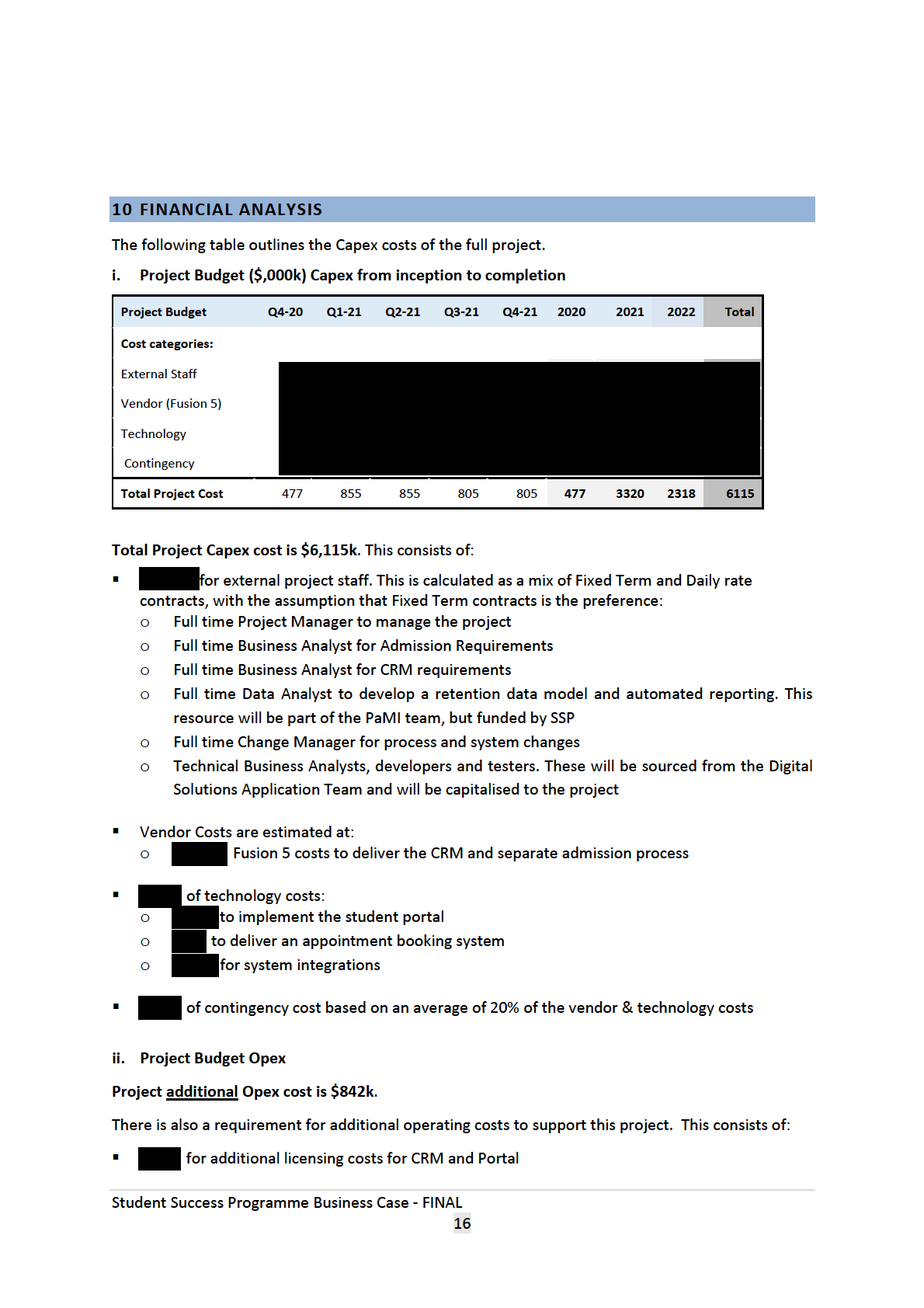
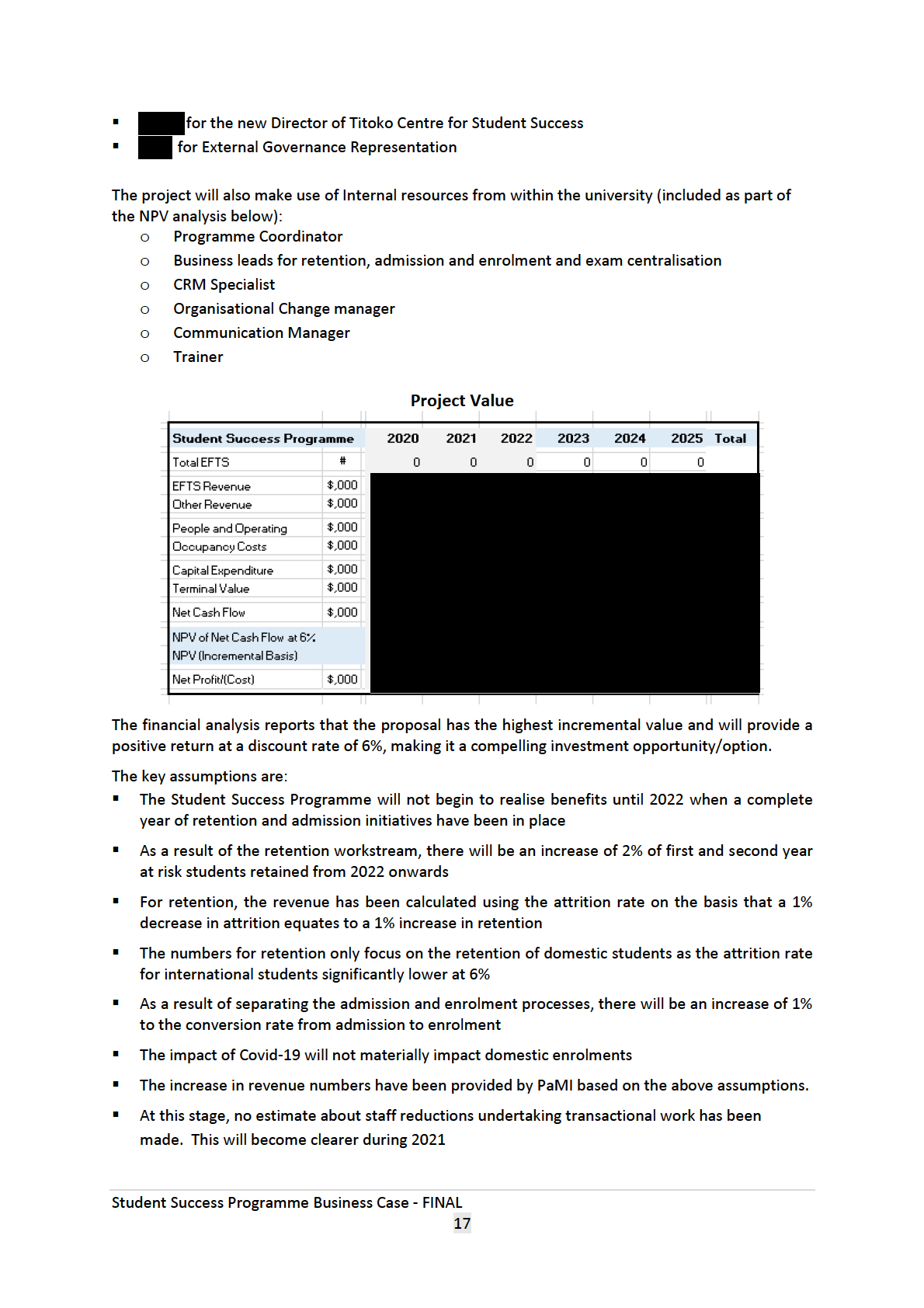
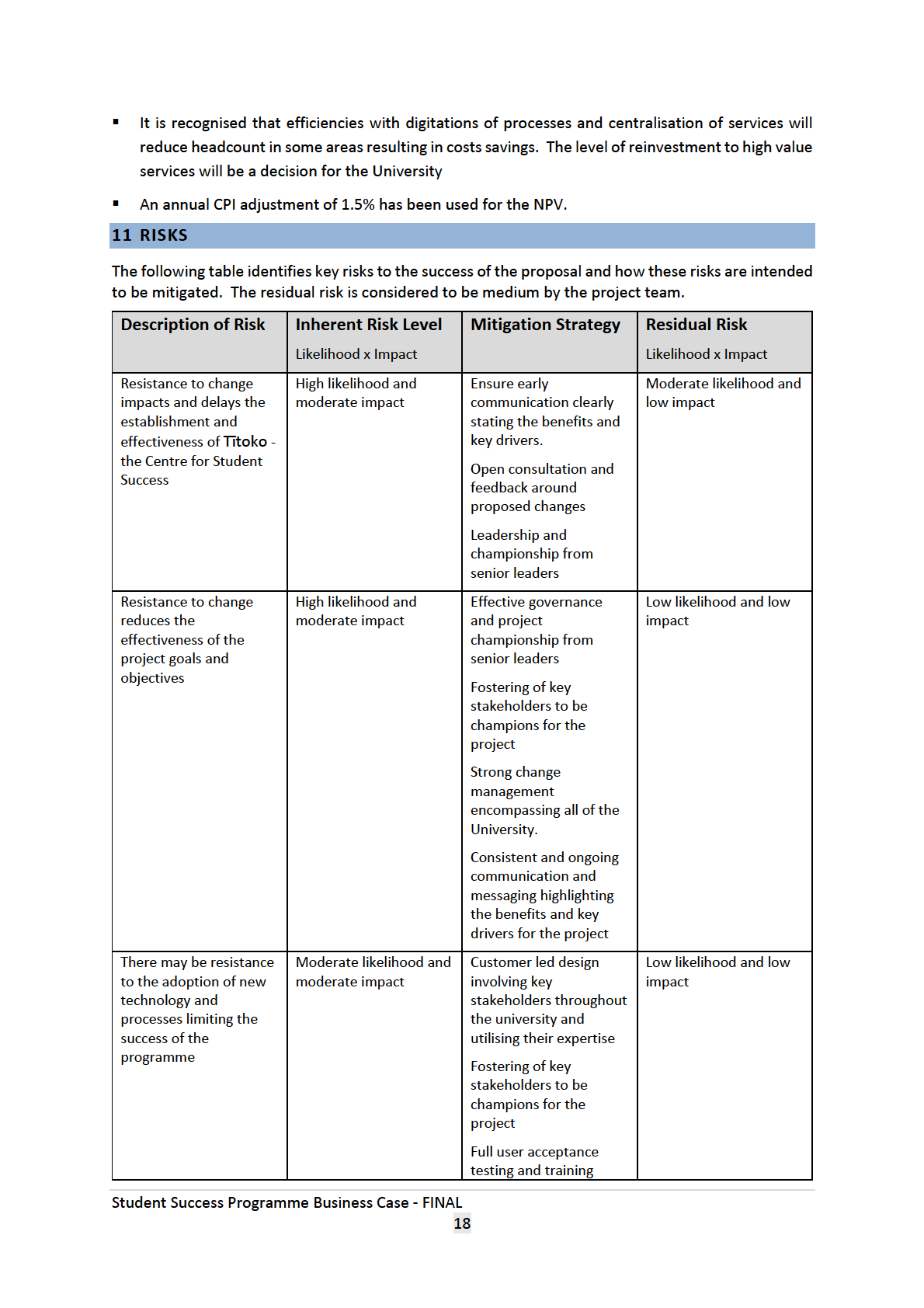
programme as part of
implementation
The degree and
Moderate likelihood and Integrations for each
Low likelihood and low
complexity of system
high impact
phase have been
impact
integrations required
identified and are clearly
could delay the project
understood
delivery
SSP chosen technology
aligns with the digital
roadmap and the
University’s IT
architecture
The integration
requirements have been
costed as part of this
project
Under estimation of the Low likelihood and high
The current admission
Low likelihood and
complexity of the
impact
and enrolment
moderate impact
admission processes
processes have been
may lead to an increased
fully documented and
timeline for the
agreed with the
development of the
admission and
required technology and
enrolment teams
process changes
Early proof of concept to
confirm understanding
of the scale of the
complexity
The project exceeds
Low likelihood and
Closely monitor budget
Low likelihood and low
forecast budget
moderate impact
via monthly governance impact
and quarterly reporting
Early identification of
significant budget
overrun to be mitigated
by reviewing scope and/
or change request
Contingency included in
budget
Working with al vendors
as partners to ensure
outcomes are achieved
within agreed budget
The project is perceived
High likelihood and
Effective governance
Moderate likelihood and
as excessive by
medium impact
and project
low impact
university staff given the
championship from
financial impact of
senior leaders
Covid-19 on the
university
The project wil clearly
articulate the benefits
and value derived from
the project through
communication, change
management process
Student Success Programme Business Case - FINAL
19


and the value
proposition.
Covid-19 may impact the Moderate likelihood and Accept the risk.
Moderate likelihood and
benefits realised by this
moderate impact
low impact
programme
The retention numbers
only consider the
domestic market which
should not be material y
impacted by Covid-19
The benefits realised
from increased
admissions have not
been considered until
2022
12 BUSINESS CASE SUBMISSION SIGN-OFFS
Project Manager
Confirm to best of my knowledge this business case is complete and accurately captures all costs,
benefits, risks and other aspects pertaining to this investment decision.
Name: Corinne Smail
Signature:
Date: 16/9/2020
Sponsor
Confirm that I have reviewed and support this business case and will take accountability for monitoring
the project execution and the realisation of the anticipated project benefits and outcomes.
Name: Wendy Larner
Signature:
Date: 16/9/2020
13 BUSINESS CASE ASSESSMENT SIGN-OFFS
Project Owners are encouraged to informally discuss the business case early in the process and
throughout with Finance, but the formal receipt date wil not commence until Submission sign-offs
above have been completed).
Date business case received for assessment: 3/9/2020
Date Finance Review completed: 10/9/2020
Signed: Clinton Jenkins, Associate Director, Planning and Performance Management
Student Success Programme Business Case - FINAL
20
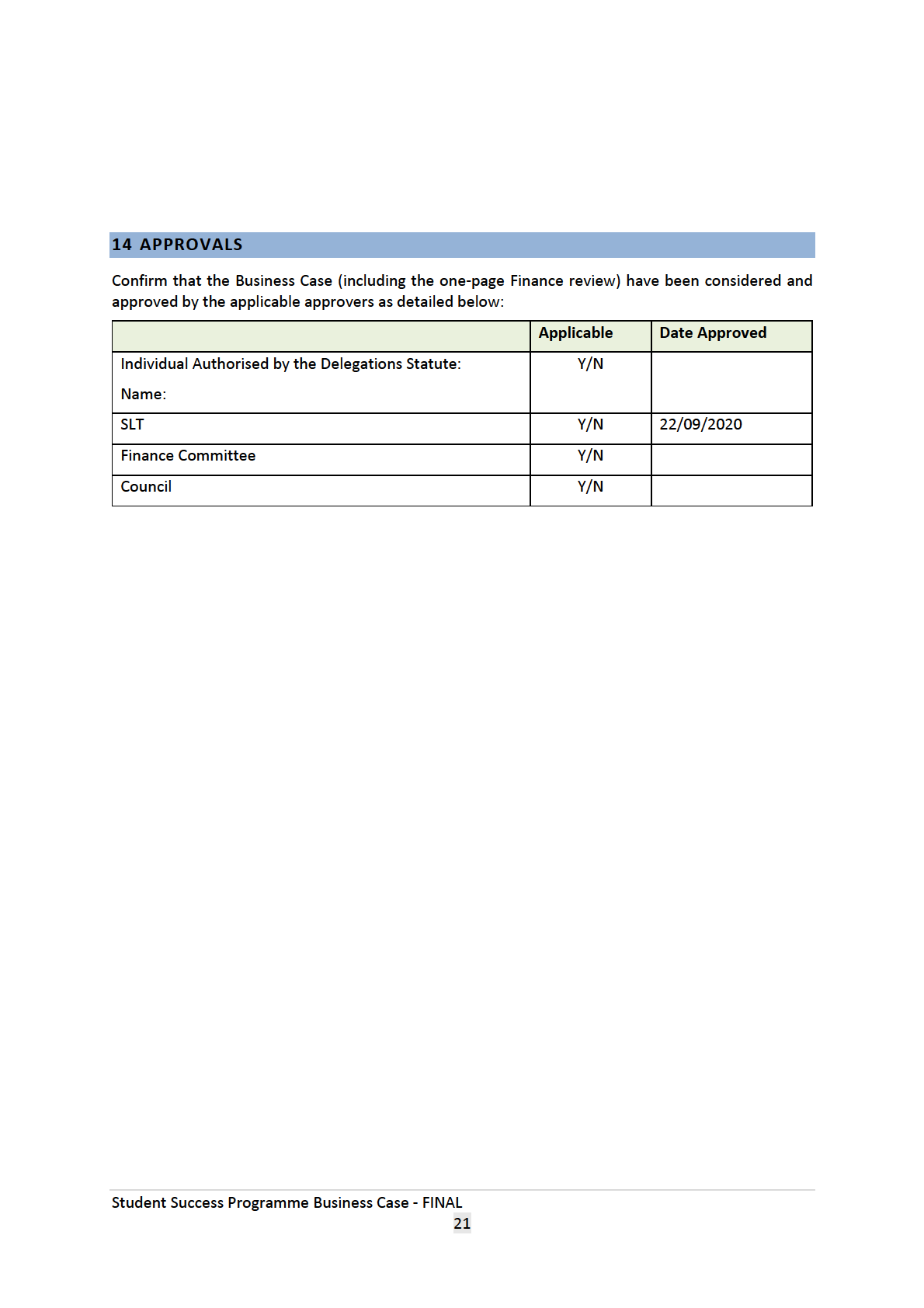
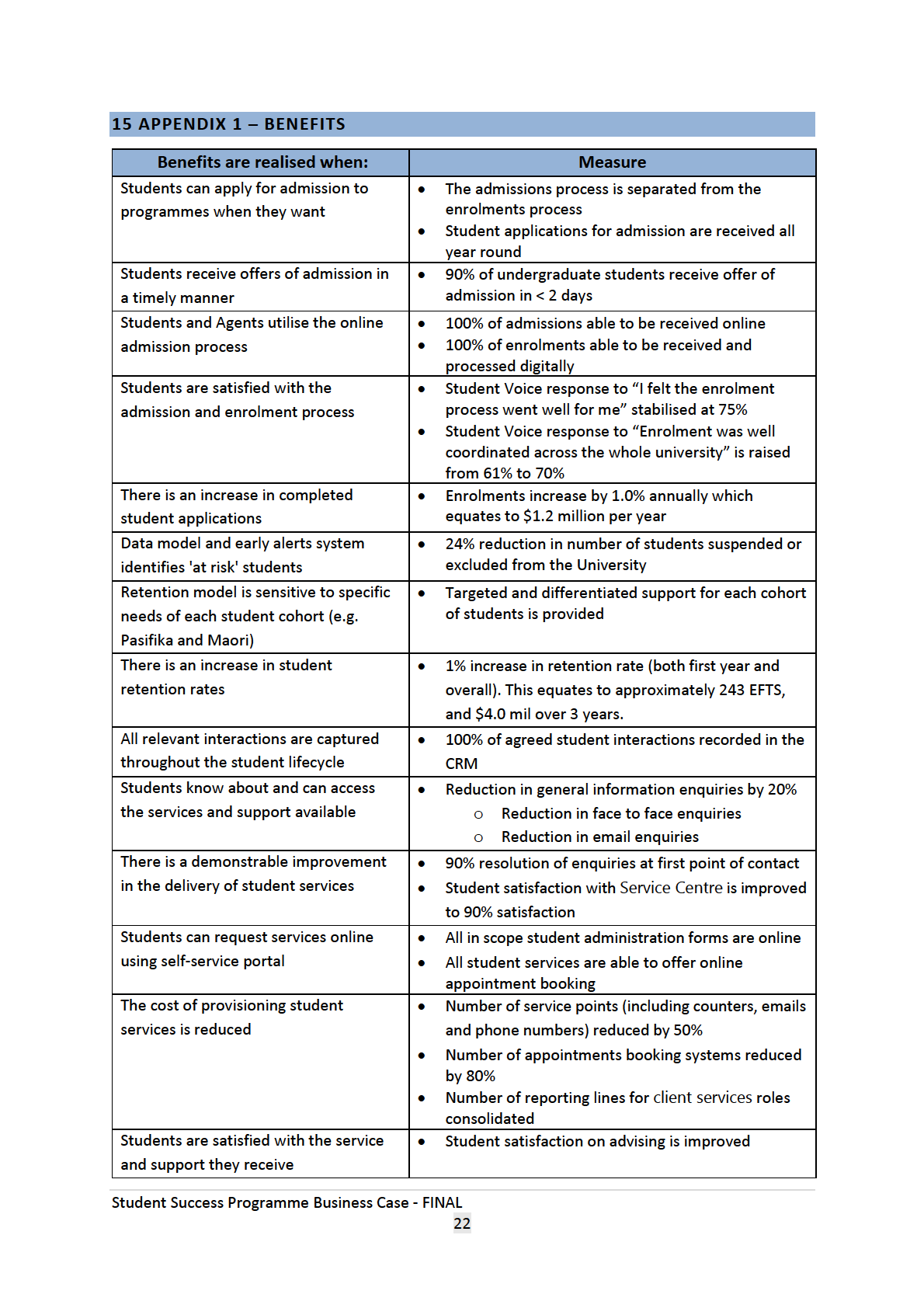
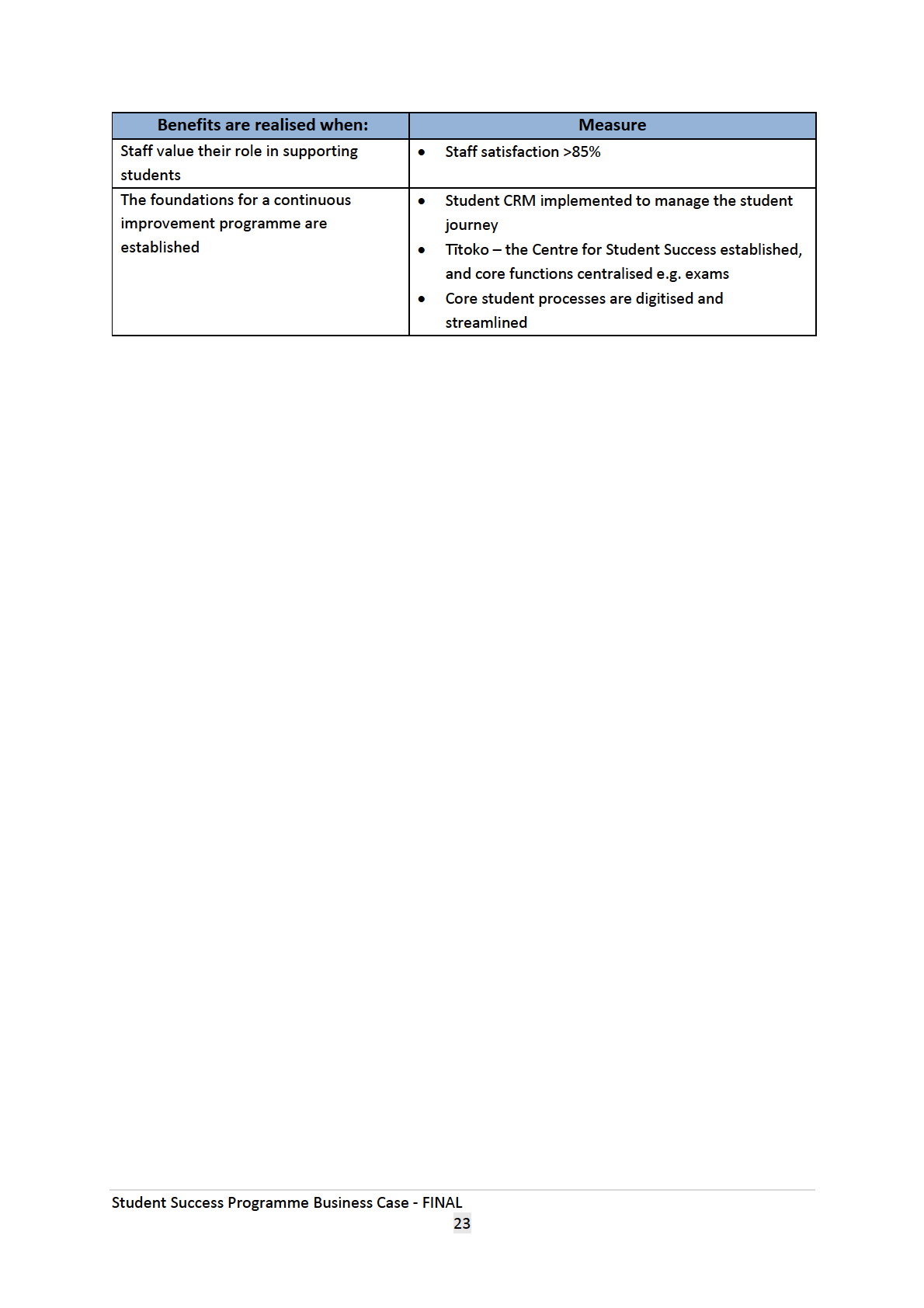
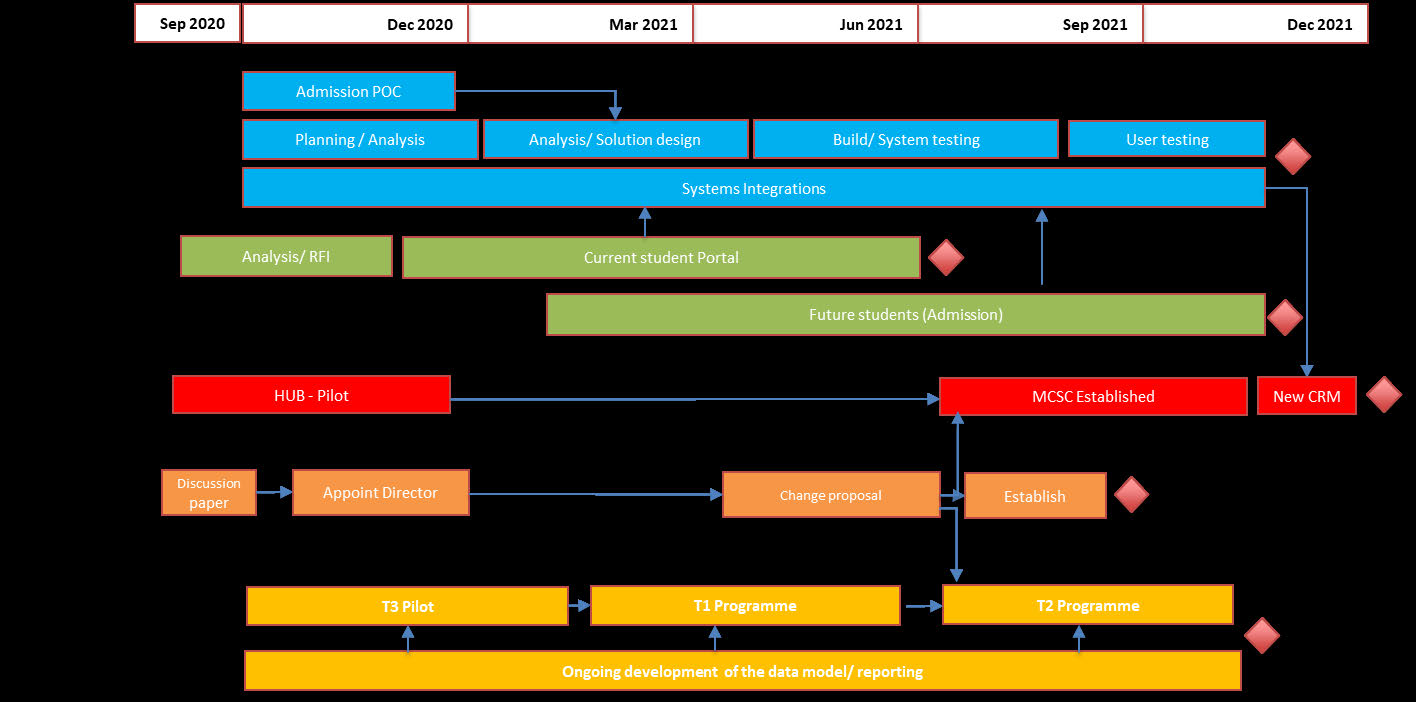 16 APPENDIX 2 – HIGH LEVEL IMPLEMENTATION PLAN
16 APPENDIX 2 – HIGH LEVEL IMPLEMENTATION PLAN
The fol owing is the high level implementation plan for Phase 1 of the project.
Note: The implementation plan for Phase 2 of the project wil be included in the Business
case update in late 2021.
Student Success Programme Business Case - FINAL
24





















